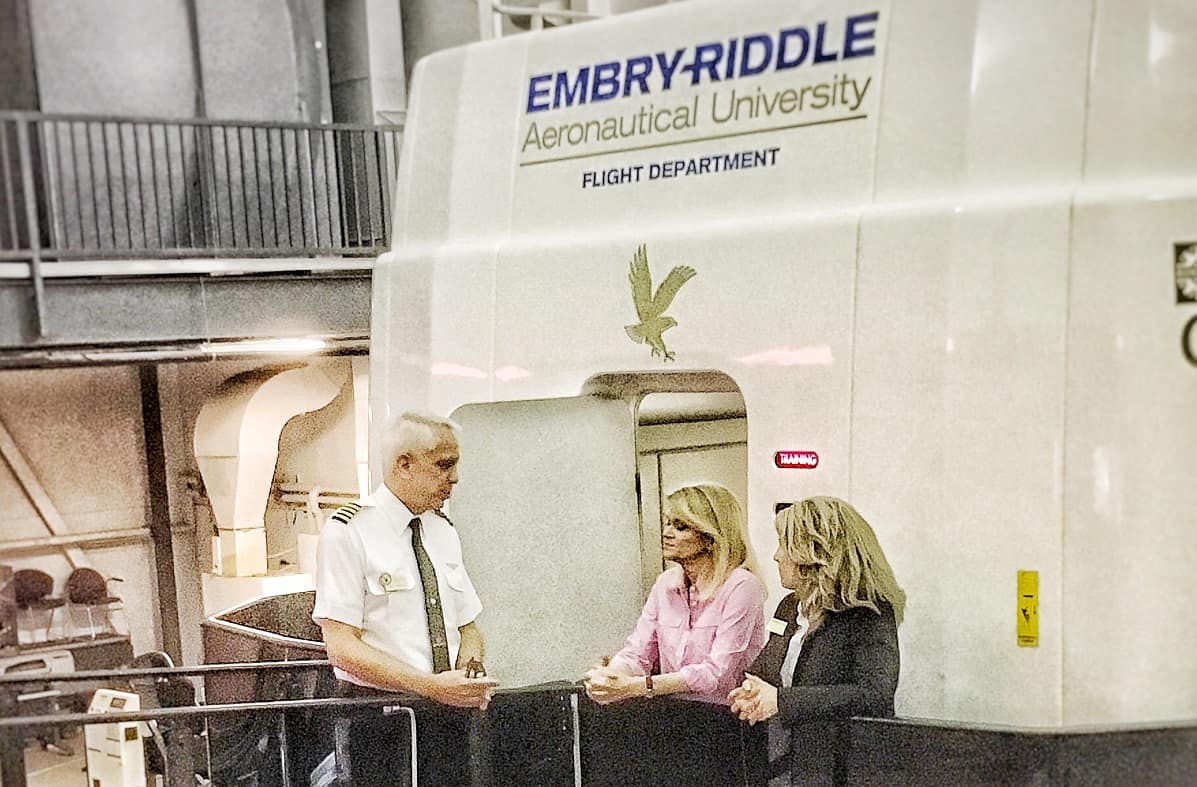Meet Michele Halleran: Pilot, Role Model, Communicator

When a Boeing 737-700 aircraft experienced engine failure shortly after takeoff on April 17, Captain Tammie Jo Shults had to rapidly declare an emergency and prioritize her next steps, veteran Embry-Riddle pilot Michele Halleran recently explained to ABC News Chief Global Affairs Correspondent Martha Raddatz.
Halleran, with fellow pilot and Advanced Simulation Program Manager Thomas Peterson on April 25 used the university’s full-motion, Level D flight simulator to reenact the Southwest Flight 1380 accident for Raddatz and a crew from ABC News 20/20.
The Embry-Riddle segment with Ms. Raddatz will soon air on the 20/20 website
“Simulation flights are critical for understanding accidents so we can prepare for them and ideally prevent them,” said Halleran, an associate professor of aeronautical science on Embry-Riddle’s Daytona Beach, Fla., campus.
Tragically, the April 17 Southwest Airlines accident claimed the life of a passenger, Jennifer Riordan of Albuquerque, N.M. Captain Shults, a former U.S. Navy pilot, was been widely lauded for her swift, calm leadership during the crisis.
As a captain, if an aircraft has engine failure and rapid cabin decompression occurs, “you instantly become a risk mitigator,” said Halleran, who has more than 5,000 total flight hours and 15 years of civilian flying experience. “You have to make sure everyone’s wearing their oxygen masks, immediately convey your emergency to the air traffic controller and run through your checklists.”
The Life of a Pilot
Halleran knows first-hand how stressful aircraft engine failure can be. While working as a private pilot, before joining Embry-Riddle in 2004, she experienced several engine failures, including one uncontained failure. “We were at an altitude of about 1000 feet,” she recalled. “We immediately declared an emergency and came back around. The aircraft was shaking and we had red lights, so we landed.”
Before teaching, Halleran’s career included flying commercial airliners for Hawaiian Airlines and Lear jets for an air ambulance company. At one point in time, she was the only female seaplane pilot in the United States. That’s how she became one of 25 aviators featured in a “Women in Flight” Smithsonian exhibit and book.
“When I was with the seaplane company, I flew winters in the Caribbean and summers in southeast Alaska,” she said. “I always wanted to go into flying. When I was in high school, I got started flying and I used all my graduation money to get my private pilot’s license.”
As a teenager, Halleran also considered becoming a doctor or a marine biologist, but she couldn’t stand the sight of blood and she grew up far from the ocean, in a landlocked area near Memphis, Tenn. She earned her bachelor’s degree from Middle Tennessee State University, her M.S.A. from Embry-Riddle and her M.B.A. from North Central University.
As pilot jobs began to disappear across the airline industry following the Sept. 11, 2001 terrorist attacks, Halleran joined Embry-Riddle. Teaching has given her an opportunity to serve as a role model for aspiring pilots – something she never previously imagined doing but finds rewarding.
It has also helped her become an exceptional communicator, as she demonstrated while explaining pilot practices to ABC’s Martha Raddatz. “Flying a plane and teaching both require clear, direct communication,” she noted.
What’s Halleran’s advice for young women and men interested in aviation? “Don’t give up. Being a pilot is definitely a worthwhile career and it’s the most fun I’ve ever had.

 Ginger Pinholster
Ginger Pinholster